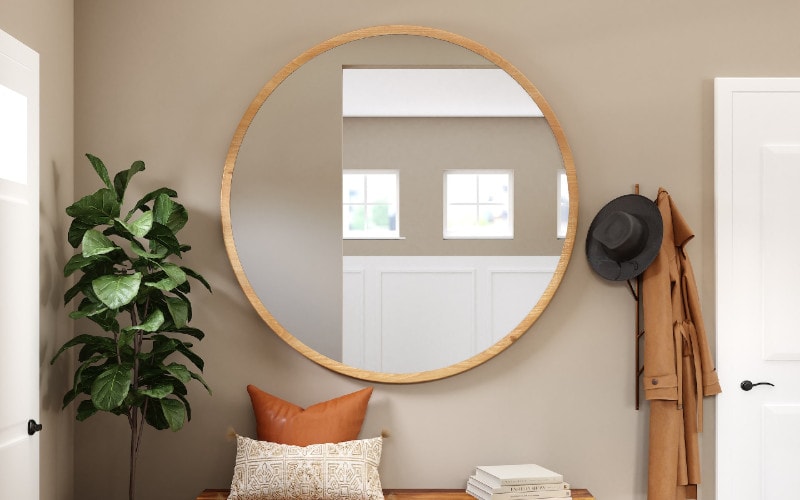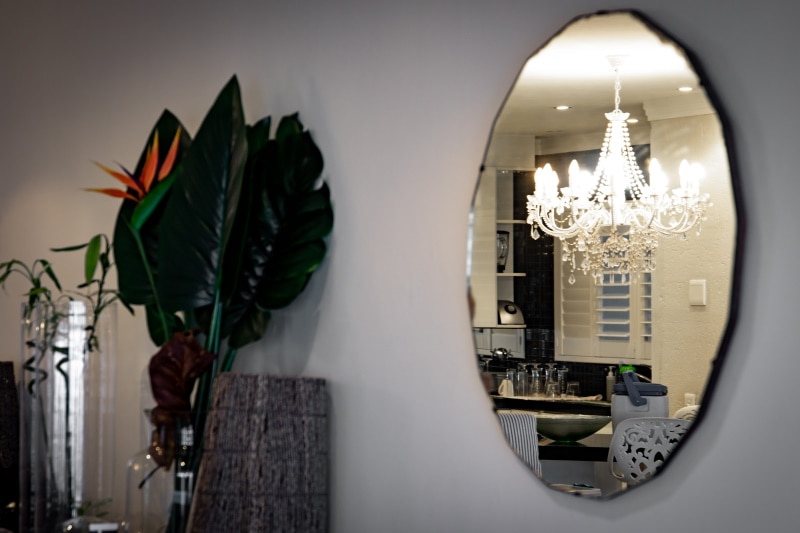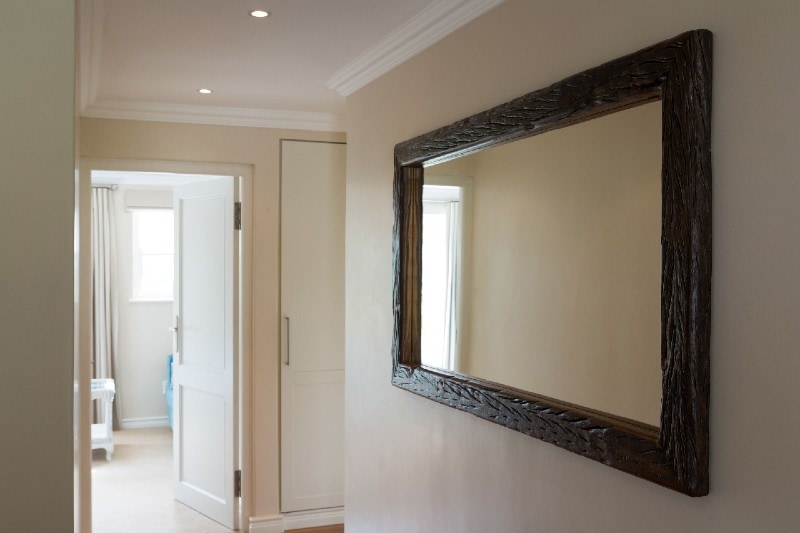How Do Mirrors Work? Laws of Reflection Explained
-

- Last updated:

Mirrors are one of the things that we often take for granted because they are literally everywhere. But have you ever stopped to think about the science behind it all?
How exactly are these smooth shiny surfaces able to create reflections that show us who we are on the outside? Some people would even argue that they are also pretty good at reminding us of who we are on the inside!
Mirrors work by reflecting light. We hope by the end of this article you will understand more about the fascinating way in which mirrors work. Let’s dive in!
How Does It Work?
It’s virtually impossible to comprehend the physics behind mirrors without first understanding the basic principles of light.
The Law of Reflection
The law of reflection says that the minute a ray of light hits a reflective surface, it instantaneously bounces off the same way a tennis ball would when thrown against a hard surface.
The path of that bounce will create two angles—the incidence and reflection angles. The former is the incoming angle, while the latter represents the outgoing and both are equal in measurement.
Let’s say you’ve woken up very early in the morning, to catch the sunrise. There’s a lake near your cabin, so you can clearly see the reflection of the sun’s rays on your window. In the morning, that light will hit the lake’s surface at a low angle and bounce off at the same low angle.
You won’t be able to look out of the window because the reflection will be so intense. But during the day, when the sun is sitting overhead, the reflection will be oblique. And it’s because the sun’s rays aren’t hitting the surface at a low angle. You’ll still see the reflection, but not directly.

What Is Diffuse Reflection?
Light is inherently invisible. However, when you force it to bounce off of something, that property changes. For example, when you’re in space, you’ll never be able to see any ray of light from the side. That’s why it’s pitch-black in some areas. But when those same rays run into an object that has the ability to scatter light, they suddenly become visible—objects like satellites and clouds of hydrogen.
That process of scattering light is scientifically referred to as diffuse reflection. And it’s how the photoreceptors in our eyes interpret what’s taking place when the rays come into contact with an uneven surface.
Seeing as there’s a surface involved in all that, the law of reflection is still applicable. The only difference between this case and that of the mirror is that we’re no longer dealing with a single smooth surface, but multiple microscopic surfaces.
And you have to be imaginative to get the general shape of the surface. It’s more or less like throwing several tennis balls at a statue and tracing the statue’s outline based on the paths created by the bounce.
What Is Specular Reflection?
The good thing about smooth reflective surfaces like that of the mirror is the fact that they aren’t designed to scatter light. That smoothness is the sole reason why light gets reflected seamlessly without tampering with the incoming image. And this form of reflection is commonly referred to as specular reflection.
“Why are the images created by a mirror-reversed?”

Well, technically, they aren’t reversed. And this shouldn’t be confusing if you think of the mirror the same way you would a rubber stamp or printing press. What they essentially do is switch the images from front to back, and vice versa.
The best way to explain this is to ask you to write something down on a piece of paper. When you hold that paper against the mirror, the words on the image will appear backward. When you hold the same piece of paper against a light source (a lamp, for example), and try to read those same words from behind, they’ll again appear backward.
That’s to say, we see the images created as a reflection, but the mirror sees them as a “light print.”
What Are the Different Types of Mirrors?
Other than a normal flat mirror, there are also curved mirrors. In general, there are two types of curved mirrors. You either have a concave mirror or a convex one.
Convex means that the mirror bulges outwards. When the ray of light hits its surface, it will be reflected at a narrower angle near the center than at the edges. This will result in an image that’s not only slightly distorted but also relatively smaller than the object.
On the flip side, we have the concave mirror. We prefer calling it the converging mirror because it collects all the different rays of light and directs them to a specific area—an area popularly known as the focal point.
From a distance, the object always looks upside down. But as you close that distance, eventually passing the focal point, the image created by the mirror flips right back and appears magnified.

In addition to concave and convex mirrors, we have other unusual types of mirrors. We’re certain that some of you have heard about the two-way, acoustic, and non-reversing mirrors.
If you’d like to create a two-way mirror, you just have to coat one side of a glass sheet using a reflective material. Such that when light hits the reflective surface, not all the rays will be reflected. Some of them will penetrate the surface, thereby making it possible for someone on the other side to see what’s happening where the light source is.
Acoustic mirrors are basically gigantic concrete dishes. And they aren’t made to distribute or reflect light, but sound. The non-reversing mirror is the brainchild of John Derby, a scientist who felt the need to create a mirror that could make you think you’re not seeing an image but an actual object. It’s also known as the “True Mirror.”
Where Are Mirrors Used?
All these mirrors are useful in one way or another. We obviously can’t list all the possible applications, so we’ll just list a couple. Convex mirrors are more favored due to their ability to create images that are smaller in size.
It allows for a wider viewpoint, hence the reason why you find convex mirrors installed in passenger vehicles as side mirrors. Fashion stores also like using convex mirrors because that slight outward bend makes clients appear taller and slimmer. They are the same mirrors installed in ATMs and used as street light reflectors.
The ability to magnify images created from any object has made the concave mirror the ideal candidate for shaving and makeup. You’ll find them installed in barber shops and beauty salons, as those are places that demand pieces of equipment that facilitate precision.
The same mirrors are also used to light Olympic torches, by focusing the sun’s rays to start the fire. Automobile manufacturers like to add them as a feature in the headlights, to serve as reflectors.
Non-reversing mirrors are more common in amusement parks, while two-way mirrors are normally installed in interrogation rooms. They are meant to help law enforcement officers to read their suspect’s body language and analyze their responses without their knowledge.

- Allows for a wider viewpoint
- Applicable indoors or outdoors
- Image shape is slightly distorted
Images created make it difficult for driver to calculate distance
- Can create magnified or diminished image
- Can be used to light a fire
- Images appear real and shapes aren’t distorted
- Can be used indoors or outdoors
- Lesser field of view
- Relatively high maintenance
Frequently Asked Questions (FAQs)
What Does the Word “Mirror” Mean?
Mirrors have been in existence for as long as we can remember. The word “mirror” was derived from the Latin word “mirari” and the French word “mirour”. In both languages, it loosely translates to “admire”. The Romans preferred calling them “speculum,” a derivative of “specere”. It means to “look” or “behold”.

What Makes Mirrors Turn Black?
If you’ve noticed black spots on your mirror’s surface, there’s a very good chance that those are rots. Yes, there is such a thing as mirror rot, and it’s usually caused by moisture found between the metal layer and the glass layer.
We’re often advised to place your mirror in a cool dry place, away from any water vapor. Because once it works its way in, there’s no stopping that metal from oxidizing, ultimately leading to black spots.
Conclusion
Mirrors abide by the laws of reflection, diffuse reflection, and specular reflection. It’s possible to see your own image whenever you look into a lake, for example, owing to the fact that the smooth surface has the ability to produce a specular reflection. But it’s impossible to see anything in ripples of water, due to diffuse reflection. Your image will be very distorted.
Featured Image Credit: Piqsels
Contents

